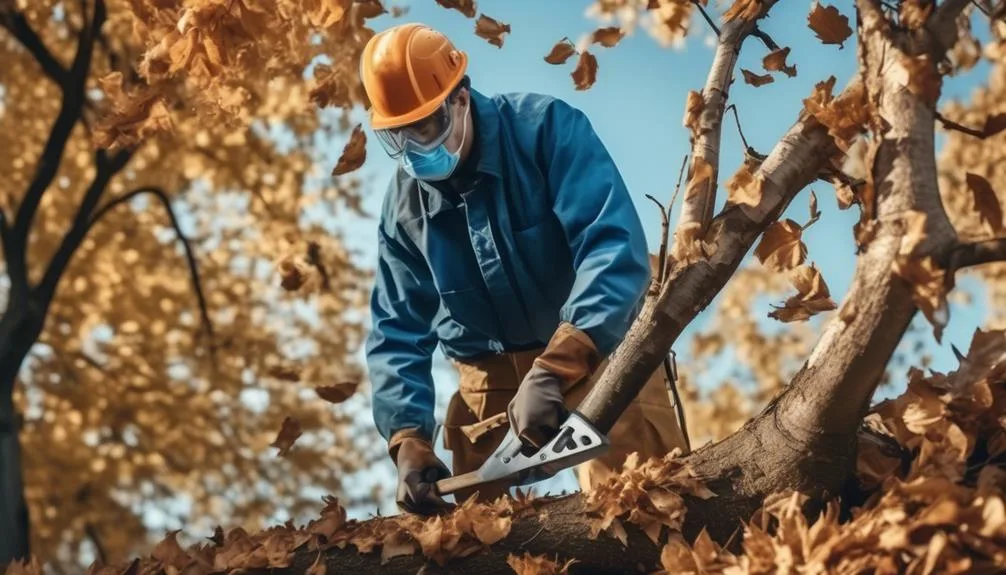Wondering how to get your hickory trees ready for winter?
As the temperature drops, it's important to prepare them for the cold months ahead.
From pruning to protecting against pests and winter watering, there are key steps you can take to keep your hickory trees healthy.
By following these measures, you can ensure your trees are strong and ready for a successful winter.
Pruning and Trimming
You may want to begin by assessing the hickory tree's branches and identifying any dead or damaged ones that need to be pruned and trimmed for optimal winter preparation. The branch structure is crucial for the tree's health and overall well-being, especially during the harsh winter months.
Inspect the branches carefully, looking for any signs of disease, pest infestation, or physical damage. Trimming away dead or diseased branches not only improves the tree's appearance but also promotes healthy growth.
Additionally, removing any branches that are crossing or rubbing against each other can prevent potential damage during winter storms.
Mulching and Fertilizing
To prepare hickory trees for winter, consider mulching and fertilizing the soil to provide essential nutrients and insulation for the tree's roots. Mulching helps maintain soil moisture and temperature, while fertilizing ensures the tree has the necessary nutrients to withstand the harsh winter conditions. When mulching, apply a layer of organic matter around the base of the tree to improve soil health and protect the roots. Additionally, fertilizing with a balanced, slow-release organic fertilizer will promote healthy growth and prepare the tree for the dormant winter months. Check out the table below for a quick reference on mulching and fertilizing hickory trees:
| Mulching | Fertilizing |
|---|---|
| Maintains soil moisture | Provides essential nutrients |
| Insulates tree roots | Promotes healthy growth |
| Improves soil health | Prepares for winter |
Protecting Against Pests
Hickory trees can be protected against pests by regularly inspecting the leaves and branches for signs of infestation, such as discoloration or unusual growths. To ensure effective pest control and maintain tree health, follow these tips:
- Prune Infested Areas: Remove and destroy any infested branches or leaves to prevent the spread of pests.
- Use Natural Predators: Encourage the presence of natural predators like ladybugs or lacewings, which feed on common hickory tree pests.
- Apply Organic Pesticides: Utilize organic pesticides specifically formulated for hickory trees to target pests while minimizing harm to beneficial insects.
Winter Watering
Winter watering is crucial for maintaining the health and vitality of hickory trees during the colder months. Even though the ground may be frozen, it's essential to monitor the soil moisture around your hickory trees.
When the ground is frozen, it prevents the roots from absorbing water, making it challenging for the tree to stay hydrated. To ensure the soil moisture remains adequate, water the trees deeply before the ground freezes. This will help the roots access water during the winter months.
If the weather fluctuates and the ground thaws, take advantage of these opportunities to water the trees.
Proper winter watering will help hickory trees stay healthy and resilient, preparing them to thrive when spring arrives.
Wrapping and Insulating
Before the arrival of winter, consider wrapping and insulating your hickory trees to protect them from harsh weather conditions. Proper insulation and wrapping techniques are crucial for safeguarding the trees during the cold season. Here's how to prepare your hickory trees for winter:
- Select Suitable Materials
- Use burlap or specialized tree wrap to shield the trunk from freezing temperatures and frost cracks.
- Ensure the material is breathable to prevent moisture buildup and the growth of fungi.
- Avoid using plastic covers, as they can trap moisture and cause more harm than good.
- Wrap the Trunk
- Start wrapping the trunk from the bottom, working your way up in a spiral motion.
- Secure the wrap firmly but not too tightly to allow for some expansion.
- Insulate the Base
- Apply a layer of mulch around the tree's base to insulate the roots and retain moisture.
Proper insulation and wrapping techniques will help your hickory trees endure the winter months effectively.
Conclusion
By implementing these proactive measures, your hickory trees will be well-equipped to withstand the challenges of winter and emerge thriving when spring arrives.
Taking the time to prune, mulch, protect, and nourish your trees demonstrates a commitment to their long-term health.
As you look ahead to the colder months, remember that your efforts now will contribute to the resilience and vitality of your hickory trees in the seasons to come.
Mark Hoffman is a dedicated arborist and tree care specialist with over a decade of experience. His love for trees began when he visited Yosemite National Park as a teenager and was awestruck by the giant sequoias. Mark pursued his passion by studying forestry at Michigan Technological University, where he earned a Bachelor of Science degree.
Since then, he has worked tirelessly in the field of arboriculture, helping to preserve and protect trees in his community. His expertise and dedication have made him a respected leader in the industry and a valuable resource for anyone seeking advice on tree care.
